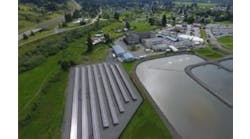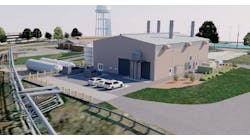We explore the opportunities solar nanogrids provide for the solar installers in a new special report series brought to you by Microgrid Knowledge and Instant ON. It turns out while one nanogrid is good, many are even better, when they come together as virtual power plants that aid the grid.
Get the full report.
Working together, solar nanogrids can achieve even greater efficiencies than they do individually. A number of projects are underway that aggregate, or pool, power from the batteries in nanogrids. These demonstrate what solar installers can achieve with nanogrids.
For example, the government of Australia partnered with one company to combine solar panels on rooftops with storage and create a virtual power plant. As we described earlier, virtual power plants operate remotely, pulling together a number of independent energy resources from different locations into a network that provides reliable power 24/7. They do so virtually, by contract, not by a physical connection.
Under the plan in Australia, 50,000 homes are being equipped with 5 kW rooftop solar panels and 13.5 kWh batteries. All together, they could provide up to 250 MW of solar and 650 MWh of storage. The Australian government is providing a $2 million grant and a $30 million loan from its Renewable Technology Fund.
Another company is planning a virtual power plant that aggregates batteries from homes in Herriman, Utah. Six hundred new rental apartments will include batteries that together will provide 12.6 MWh of energy, based on stored solar in the batteries.
Such systems are not only valuable to the solar and storage owners, but together, as virtual power plants, they also can provide a resource option for utilities challenged by the need to meet peak demand for power. Acting as a grid resource, the virtual power plant can provide power when demand is high and help utilities avoid building expensive fossil fuel peaker plants, which lowers costs for ratepayers. More and more, energy storage is seen as a way to help meet this need.
Virtual power plants in California
California offers several good examples of how virtual power plants can aid the grid. The state was among the first to advance the idea of relieving pressure on the grid by intelligently distributing the power generated by individual distributed energy resources (DERs) during periods of peak load. Additionally, California demonstrated that the combined power generation, storage and consumption of the networked DERs in the virtual power plant can be aggregated and traded on the energy exchange.
For example, Southern California Edison in 2019 achieved a new world record with a virtual power plant delivering 2 GWh of grid services. In 2018 —its first year of operation—the virtual power plant was dispatched 250 times to the California Independent System Operator. The project’s fleet of 21 hybrid electric buildings is capable of reducing peak demand by up to 10 MW within minutes of receiving an automated signal from California’s grid operator.
But California isn’t alone in its need for peak power, and therefore virtual power plants. The Department of Energy’s National Renewable Energy Laboratory (NREL) said in a recent study that the US needs more than 50 GW of storage to ensure peak demand needs are met. The study found that providing peaking capacity could be a significant market for those who own energy storage systems. This potential is especially promising for batteries that can provide storage for four hours. Adding renewable generation can increase energy storage’s potential by altering the shape of demand patterns.
For both solar installers and homeowners interested in installing nanogrids, that’s good news. With the right incentives in place, battery owners can provide peaking power to the grid—and get paid for what it’s worth. That helps utilities avoid building expensive peaker plants, which lowers costs for ratepayers and helps the grid.
While selling power to the grid from nanogrids may sound like science fiction, a number of factors are coming together to help make these ideas reality. Solar installers and homeowners are important players in this future.
One alternative—using nanogrids when solar production is too high—would look like this: Homeowners with nanogrids would continue normal operations. But they would give the utility access to empty batteries that could absorb the excess solar.
Absorbing excess renewable energy
Another important challenge on the grid is the need to absorb solar energy and other forms of renewable energy when they produce more than the grid can handle. When this happens, precious renewable energy can be wasted.
In fact, during the summer of 2019, California set records for the most solar power ever coming onto the state’s main electric grid, and the most solar power ever taken off the grid because it wasn’t needed.
Nanogrids can help solve this problem and make use of solar that would otherwise be wasted because it’s possible to free up their batteries to absorb the excess solar. This is an alternative to an “excess supply demand response” program offered by Pacific Gas & Electric (PG&E) and other utilities under which customers increase energy usage to absorb the solar. The excess supply demand response program aims to avoid curtailing solar or paying other states to take excess energy, but the associated boost in energy usage has environmental effects. This program faces challenges, including engaging customers to participate.
One alternative—using nanogrids when solar production is too high—would look like this: Homeowners with nanogrids would continue normal operations. But they would give the utility access to empty batteries that could absorb the excess solar. For example, a project for PG&E from Olivine allows excess generation to fill up batteries when there’s too much solar on the grid.
This type of program benefits customers, utilities, the grid and the environment.
Nanogrids not only provide these grid benefits, they also offer public safety advantages.
In the coming weeks, this special report article series will explore the following topics exploring solar nanogrids:
- Nanogrids: A New Opportunity for the Solar Industry & its Customers
- How Nanogrids Assist with Public Safety — Wildfires, Power Outages and Other Challenges
- What Can Regulators and Utilities Do to Boost Solar Nanogrids?
Download the full report, “Nanogrids: A New Opportunity for the Solar Industry,” courtesy of Instant ON, to learn more.







